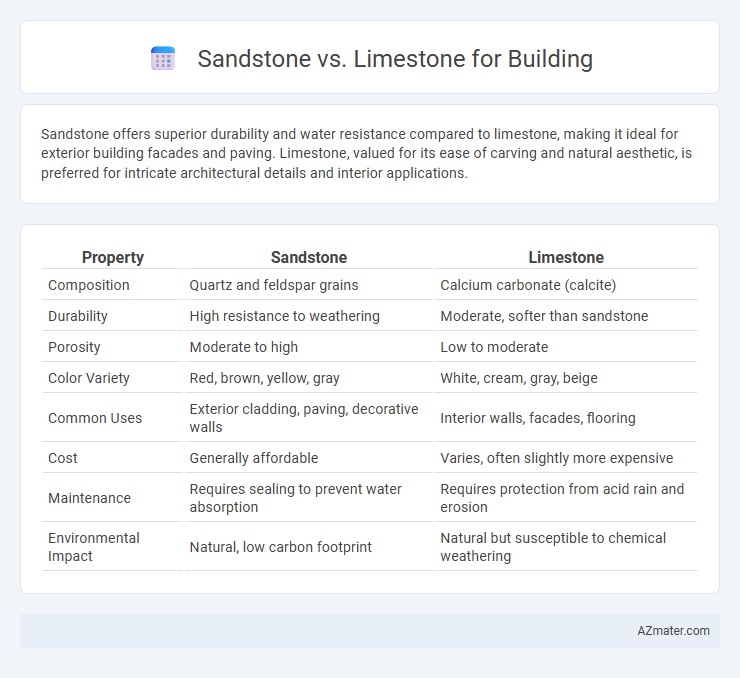Sandstone offers superior durability and water resistance compared to limestone, making it ideal for exterior building facades and paving. Limestone, valued for its ease of carving and natural aesthetic, is preferred for intricate architectural details and interior applications.
Table of Comparison
| Property | Sandstone | Limestone |
|---|---|---|
| Composition | Quartz and feldspar grains | Calcium carbonate (calcite) |
| Durability | High resistance to weathering | Moderate, softer than sandstone |
| Porosity | Moderate to high | Low to moderate |
| Color Variety | Red, brown, yellow, gray | White, cream, gray, beige |
| Common Uses | Exterior cladding, paving, decorative walls | Interior walls, facades, flooring |
| Cost | Generally affordable | Varies, often slightly more expensive |
| Maintenance | Requires sealing to prevent water absorption | Requires protection from acid rain and erosion |
| Environmental Impact | Natural, low carbon footprint | Natural but susceptible to chemical weathering |
Introduction to Sandstone and Limestone
Sandstone, a sedimentary rock composed mainly of quartz and feldspar, features a granular texture and offers excellent durability and weather resistance, making it a popular choice for building facades and decorative elements. Limestone, primarily made of calcium carbonate, presents a softer and more porous structure, often favored for its workability and classic aesthetic in architectural designs. Both stones have distinct physical and geological properties that influence their sustainability and suitability in construction projects.
Geological Formation and Composition
Sandstone, primarily composed of quartz and feldspar grains cemented by silica, calcite, or iron oxides, forms through the lithification of sand-sized sediment particles in environments such as rivers, beaches, or deserts. Limestone consists mainly of calcium carbonate derived from marine organisms' skeletal fragments, accumulating in warm, shallow marine waters and undergoing chemical precipitation or biogenic accumulation. The porous structure of sandstone contrasts with the often denser, more crystalline structure of limestone, influencing durability and weathering characteristics in building applications.
Physical Appearance and Color Variations
Sandstone exhibits a granular texture with distinct layers, offering colors ranging from warm reds, browns, and yellows to lighter creams, creating a rustic and earthy aesthetic. Limestone features a smoother, more uniform surface with subtle fossils often visible, showcasing a palette of soft whites, greys, and beiges, lending a classic, elegant look. Both stones vary in hue and pattern, but sandstone's coarse grain contrasts with limestone's fine, homogeneous appearance, influencing design choices in architectural applications.
Durability and Weather Resistance
Sandstone exhibits high durability and excellent weather resistance due to its dense, tightly bonded grains, making it ideal for exterior building applications exposed to harsh climates. Limestone, while strong and versatile, is more susceptible to acid rain and erosion because of its calcium carbonate composition, which can lead to surface degradation over time. Choosing sandstone over limestone ensures longer-lasting structural integrity and reduced maintenance in environments with frequent moisture and weather fluctuations.
Workability and Ease of Carving
Sandstone offers excellent workability and ease of carving due to its relatively soft and granular composition, making it ideal for detailed architectural elements and decorative features. Limestone, while generally softer than many other stones, has a finer, more uniform grain that also allows precise carving but may require more skill to prevent chipping. Both stones are popular in construction; however, sandstone's porosity provides better adaptability for intricate designs, whereas limestone is favored for smoother finishes and classical detailing.
Cost Comparison: Sandstone vs Limestone
Sandstone typically costs more than limestone due to its durability and unique textures, with prices averaging $50 to $100 per square foot compared to limestone's $40 to $80 per square foot. Limestone's affordability is attributed to its widespread availability and easier quarrying process, making it a cost-effective option for large-scale construction. Both materials require maintenance costs that vary based on climate, but sandstone's longer lifespan can result in lower long-term expenses despite higher initial investment.
Suitability for Different Climates
Sandstone offers superior durability and weather resistance, making it ideal for harsh or wet climates due to its dense composition and ability to withstand freeze-thaw cycles. Limestone, being more porous and softer, is better suited for dry, mild climates where moisture exposure and weathering are minimal. Choosing between sandstone and limestone for building projects heavily depends on local climate conditions to ensure long-term structural integrity and aesthetic preservation.
Architectural and Aesthetic Applications
Sandstone offers a warm, earthy palette and granular texture that enhances rustic and traditional architectural designs, making it ideal for facades, cladding, and intricate carvings. Limestone provides a smoother surface and lighter tones, favored in classical and contemporary structures for its elegant finish and ease of sculpting detailed ornamentation. Both materials exhibit excellent durability and weather resistance, but sandstone's porosity suits dry climates while limestone requires sealing in wetter environments to maintain its aesthetic appeal.
Maintenance and Long-term Care
Sandstone requires regular sealing to prevent water absorption and weathering, maintaining its durability over time. Limestone is more porous and sensitive to acidic conditions, necessitating frequent cleaning and protective treatments to avoid erosion and surface damage. Both materials benefit from periodic inspection and gentle cleaning methods to preserve structural integrity and aesthetic appeal in building applications.
Environmental Impact and Sustainability
Sandstone offers natural durability and low embodied energy, making it a sustainable choice with minimal environmental degradation during quarrying. Limestone, while also durable, often requires more intensive processing and can result in higher carbon emissions due to calcination in cement production. Both stones have good thermal mass properties that contribute to energy efficiency in buildings, but sandstone's lower extraction impact often positions it as the environmentally preferable option.

Infographic: Sandstone vs Limestone for Building
 azmater.com
azmater.com